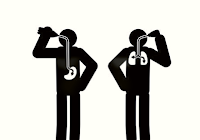Pharmacokinetics - Principles Of Pharmacokinetics And Pharmacokinetics Definition
9/19/18
Edit
Pharmacokinetics - Principles Of Pharmacokinetics And Pharmacokinetics Definition
Pharmacokinetics is any process that is carried out against drugs, includes : absorption, distribution, metabolism or transportation or bio transportation and excretion.
1. Absorption Of Drugs
absorption is the process of absorption of a drug from a place of granting entry to the blood circulation. general absorption of drugs through a process of passive diffusion, i.e water soluble drug molecules on the surface of the cell membrane, and then crosses the membrane dissolves in fat with membrane and dissolves in the liquid cell. this process is continued until the levels of drugs outside cells same with the inside of the cell.
2. Transportation Drug
transportation drug is defined as a process the drug crosses cell membranes or semipermeable News (can only be traversed by certain substances). there are several mechanisms of drug, namely trans-for as following Picture prnciples of Pharmacokinetics.
The Mechanism Of Trans-for
A. mechanism of trans-for Passively Drug
drug passively trans-for mechanism means that does not require energy :
1. filtration through the small pores of the cell membrane, which through this process is generally a drug that had smaller molecular size of the pores, for example : urea, ethanol, antipirin, and others.
2. diffusion, i.e. a substance dissolves in fatty layers of the cell membrane, and then dissolve again into the liquid cell. this way is the most common drug trans-for for a substance that is soluble in fat (lipofil).
B. Mechanism To Actively Cure Trans-for
the mechanism of drug trans-for actively transport requires energy means done with binding substances hydrofoil (macro molecules or ion) in the enzyme specific carrier, after the elapse of the membrane, removable back medicine.
for example : glucose, amino acids, fatty acids and other nutritional substances and drugs that the structure resembles a : of 1-dopa, 1-dopa methyl 5-flurourasil, generally in the resorption through this process.
3. Drug Distribution
the distribution of drugs is as dissemination of drug throughout the body via the circulatory system with the distribution of the drug is expected to be quickly gets to a certain organ misbehaving or damage, so the treatment process take place. there are 2 phases of drug distribution.
2. Phases Of Drug Distribution
a. The distribution of first phase occurs immediately after the absorption of the drug, that is, to the organ perfusion very well, for example : heart, liver, kidneys and brain.
b. Second Phase Distribution
occurs at the perfusion organs are not as good as the above organs, such as muscle, skin and fatty tissue.
4. Metabolism Or Drugs Bio-transformation
bio-transformation or drug metabolism is an shake-up or changes the chemical structure of the drug into a generally inactive metabolism and more are making it easier for hydrofoil in excretion through the kidneys.
most drugs metabolism done inside the heart, other organs for example; kidney, lung wall colon and others. example of drug metabolic reactions are :
a. Drug Structure Reshuffle Reaction :
1. Oxidation : for example : alcohol, aldehyde, acid, and carbohydrogen substance is oxidized CO2 + H2O.
2. Reduction : for example : kloralhydras reduce to trikloretanol.
3. hidrolisa : drugs + H2O = break into two or more parts.
b. Incorporation Of Drugs Reaction
drug molecules join with a molecule that is present in the body and excrete water, e.g. substances as follows :
1. Sour vinegar (Asetilasi) : bind the amino group can not be hydrolysis, for example asetilasi sulfonamides.
2. Sulfuric acid : tie a phenol-OH group into esters.
3. Acid Glucoronat : from glukoronida by tying the-OH group
4. Methylation : the drug molecules join cluster-CH3, e.g. adrenaline into metoksiadrenalin.
4 Factors That Can Affect The Speed Of The Bio-Transformation Of The Drug :
1. factors of liver function
drug metabolism in liver disorders can be faster or slower, so that drug effects can be weak or strong
2. The Age factor
not all of the enzymes in the baby hat is formed, so the slower the metabolic reactions. while at the ripe old age of many organs Physiology function decreases, so the reactions of metabolism will also be slower.
3. Genetic Factors
there are people who do not have a specific genetic factors, for example enzymes for astilasi, as a result the reshuffle involving the enzymes will slow once.
4. The Use Of Other Drugs
certain drugs that are lipofil can be stimulant the formation and activity of liver enzymes (enzyme induction) so drug metabolism is accelerated for example : the barbiturates, the analgesics, anti epileptic and other.
on the contrary there are also drugs that inhibit drugs (inhibit activity of liver enzymes so that the drug slowed metabolism.
for example L coagulant, anti diabetics, sulfonamides, oral antidepressant, allopurinol, metronizadol, and others.
5. Drug Excretion
excretion is the process of dispensing a drug or the metabolite from the body, this primarily by renal excretion through the urine. excretion of drugs also occur through sweat, saliva, tears, breast milk, and others, and it's relatively small in number.
drug excretion through the kidneys will plummet if kidney function is interrupted so that the dose of the drug need to be lowered or the granting of extended intervals.
